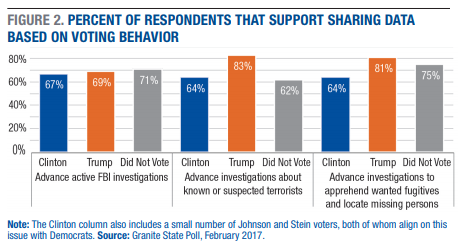download the brief
Key Findings




Law enforcement agencies are increasingly using facial recognition technology to scan a database of photos maintained by Federal Bureau of Investigations (FBI). Currently 21 states, though not New Hampshire, share Department of Motor Vehicles (DMV) data with the FBI in support of its effort to build a massive database of over 400 million photos to which it applies facial recognition technology. Between May 2017 and April 2019, the FBI’s Criminal Justice Information Services Division received 152,565 facial recognition search requests from law enforcement agencies.1 Moreover, U.S. Immigration and Customs Enforcement has combed DMV databases with facial recognition technology to identify undocumented immigrants.2
We wanted to know how New Hampshire residents would feel about having their driver’s license photos shared with the FBI and whether certain reasons to share photos would be more convincing than others.
In our polling, we used language from the typical agreement that the 21 states have with the FBI to describe three reasons to share driver’s license photos:
- To “advance active FBI investigations.”
- To “apprehend wanted fugitives and known or suspected terrorists.”
- To “locate missing persons nationwide.”
We also looked at how political affiliation, gender, and region of residence within the state affected the results.
Methodology
The findings presented here are based on a Granite State Poll, conducted by the University of New Hampshire Survey Center, between January 31 and February 8, 2017. Five hundred and five randomly selected New Hampshire adults were interviewed by live interviewers in English on landline and cellular telephone.
We used a split-ballot survey experiment in which respondents were randomized into three groups. We posed separate questions to each of the three groups to determine whether sharing of photos is more acceptable to the public based on the articulated reasons in the agreements. Respondents were asked to indicate whether they agreed or disagreed with the following statements:
- “Following the example of 18 other states, the Department of Motor Vehicles in New Hampshire should share their drivers’ license photos with the FBI Facial Analysis, Comparison, and Evaluation Services Unit to advance active FBI Investigations.”
- “Following the example of 18 other states, the Department of Motor Vehicles in New Hampshire should share their drivers’ license photos with the FBI Facial Analysis, Comparison, and Evaluation Services Unit to advance active FBI Investigations about known or suspected terrorists.”
- “Following the example of 18 other states, the Department of Motor Vehicles in New Hampshire should share their drivers’ license photos with the FBI Facial Analysis, Comparison, and Evaluation Services Unit to advance active FBI Investigations to apprehend wanted fugitives, and locate missing persons nationwide.”
Majority Support Sharing Photos

Figure 1 shows that for each of the mentioned reasons, about 70 percent of Granite Staters are in favor of sharing data, regardless of the reason. There were no significant differences in support, even if terrorism or specific cases like fugitives and missing persons were mentioned.3

Differences by Voting Behavior
Large majorities of both Trump and Clinton voters as well as nonvoters support sharing data, although Trump voters are generally more supportive (Figure 2), particularly when it comes to sharing data to capture potential terrorists. Trump voters overwhelming supported this rationale at 83 percent, compared to 62 percent of nonvoters and 64 percent of Clinton voters. We saw similar differences between Trump and Clinton voters when asked if they would support sharing data for purposes of apprehending wanted fugitives and locating missing persons.
Differences by Gender
Gender is a strong predictor of support for the use of facial recognition data. Women are more supportive than men, with rates exceeding men’s by 17 percentage points on average (Figure 3). Women are especially convinced by the terrorism argument, with 86 percent expressing support for data sharing in cases of investigating known or suspected terrorists. Only 58 percent of men felt similarly.
Differences by New Hampshire Region
We wanted to examine how two of the major population centers—the Manchester area and the Seacoast4—compared to the remainder of the state (Figure 4). On average, Manchester and the Seacoast are less supportive of picture sharing for facial recognition by an average of 8 percentage points across the different rationales. Politically, both areas lean slightly left of center, which might explain the results, and the results might also indicate concerns that have been resonating in larger city centers across the United States about the use of the technology.

Stepping Into the Unknown Territory of Facial Recognition Technology
The implications of the use of facial recognition technology are vast, and but they have yet to receive the attention needed by policymakers.
In a July 2018 blog post titled “Facial Recognition Technology: The Need for Public Regulation and Corporate Responsibility,” Brad Smith, president of Microsoft Corporation, noted the positive aspects of facial recognition, such as allowing the capture of a terrorist before he or she acts, but also shared his concerns. He wrote:
[I]magine a government tracking everywhere you walked over the past month without your permission or knowledge. Imagine a database of everyone who attended a political rally that constitutes the very essence of free speech. Imagine the stores of a shopping mall using facial recognition to share information with each other about each shelf that you browse and product you buy, without asking you first. This has long been the stuff of science fiction and popular movies—like “Minority Report,” “Enemy of the State,” and even “1984”—but now it’s on the verge of becoming possible.
The New York Times recently reported that the Chinese government is using a massive facial recognition platform to “track and control the Uighurs,” a Muslim minority.5
New Hampshire is one of the few states comprehensively addressing the collection of biometric data. In most instances, the state is prohibited from collecting and storing this information, and it has banned the use of facial recognition technology through the use of body-worn cameras. The state prohibits the sharing of driver’s license data, including facial images, with the federal government “for the purpose of creating or enhancing a federal identification database.”6 However, the legislature is currently considering how commercial entities may use facial recognition technology.
A discussion among law enforcement, policymakers, and the public seems imperative as the use of facial recognition technology continues to expand.
Endnotes
- The Use of Facial Recognition Technology by Government Entities and the Need for Oversight of Government Use of This Technology upon Civilians: Hearings before the Committee on Oversight and Reform, U.S. House of Representatives, 116th Cong. 3 (2019) (Testimony of Kimberly Del Greco).
- Catie Edmonson, “ICE Used Facial Recognition to Mine State Driver’s License Databases,” New York Times, July 7, 2019.
- All data comparisons in this brief but one are statistically significant at p-values .05 or lower. The exception was in comparing “who one voted for” and his or her willingness to share data to “advance active FBI investigations.” This one data comparison approached significance at the .09 level but was not significant.
- Manchester Region includes Allenstown, Auburn, Bedford, Bennington, Candia, Chester, Deering, Francestown, Fremont, Goffstown, Greenfield, Hillsborough, Hooksett, Lyndeborough, Manchester, Mont Vernon, New Boston, Raymond, Weare, and Windsor. Seacoast Region includes Barrington, Dover, Durham, Epping, Exeter, Greenland, Hampton, Hampton Falls, Lee, Madbury, New Castle, Newfields, Newington, Newmarket, North Hampton, Nottingham, Portsmouth, Rochester, Rollinsford, Rye, Seabrook, Somersworth, and Stratham.
- Paul Mozur, “One Month, 500,000 Face Scans: How China Is Using A.I. to Profile a Minority,” New York Times, April 15, 2019.
- NH Rev Stat § 260:14 (2015).
About the Authors
Dan Bromberg is an Associate Professor of Public Administration and Political Science in the Carsey School of Public Policy and the Department of Political Science at the University of New Hampshire. He is the Director of Academic Programs for the Carsey School of Public Policy. Dan’s research focuses on public management and organizational accountability. Recent publications include Gatekeepers: How Procurement Personnel Guard against Hybrid Accountability, Pay-to-Play: An Examination of State Laws, and Body Worn Cameras and Policing: A List Experiment of Citizen Overt and True Support.
Étienne Charbonneau is the Canada Research Chair in Comparative Public Management at École nationale d’administration publique, Montreal, Canada. His research focuses on citizen satisfaction and accountability. Some of his current research projects have to do with public support for surveillance. Recent publications include Citizens Respond to Outputs, Outcomes, and Costs: A Survey Experiment about an HIV/AIDS and Process Tracing in Public Administration: The Implications of Practitioner Insights for Methods of Inquiry.
Andrew Smith has been Director of the University of New Hampshire Survey Center since 1999 and is Professor of Practice in the UNH Department of Political Science. He has published in multiple journals, including APSR and POQ, and is co-author with David Moore of The First Primary: New Hampshire’s Outsize Role in Presidential Nominations. His recent research focus is on methodological issues in survey research.
